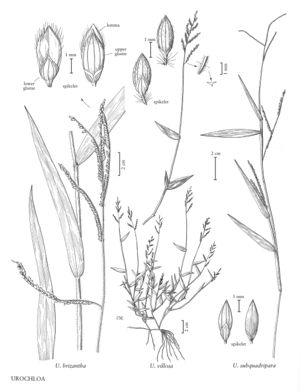Difference between revisions of "Urochloa subquadripara"
FNA>Volume Importer |
FNA>Volume Importer |
||
| Line 41: | Line 41: | ||
|publication year= | |publication year= | ||
|special status= | |special status= | ||
| − | |source xml=https://jpend@bitbucket.org/aafc-mbb/fna-data-curation.git/src/ | + | |source xml=https://jpend@bitbucket.org/aafc-mbb/fna-data-curation.git/src/f6b125a955440c0872999024f038d74684f65921/coarse_grained_fna_xml/V25/V25_1327.xml |
|subfamily=Poaceae subfam. Panicoideae | |subfamily=Poaceae subfam. Panicoideae | ||
|tribe=Poaceae tribe Paniceae | |tribe=Poaceae tribe Paniceae | ||
Revision as of 19:22, 24 September 2019
Plants annual or short-lived perennials. Culms 10-70 cm, decumbent, branching and rooting at the lower nodes; nodes glabrous; internodes glabrous or sparsely pilose distally. Sheaths mostly pubescent or glabrous, margins ciliate; ligules 0.5-1.3 mm; blades 2-15(27) cm long, 3-10 (12) mm wide, glabrous or pubescent; margins scabrous, sometimes ciliate basally; bases subcordate, not clasping the stems. Panicles 2.5-13(22) cm, with 3-6(9) spikelike primary branches in 2 ranks; primary branches 2-7 cm, ascending to reflexed, axes 0.7-1.2 mm wide, flat and narrowly winged, margins scabrous; secondary branches absent; pedicels shorter than the spikelets, scabrous. Spikelets 3.3-3.8 mm long, 1-1.4 mm wide, solitary, appressed to the branches, in 2 rows. Glumes separated by 0.3-0.5 mm; lower glumes 1.4-1.7 mm, 1/3 – 1/2 as long as the spikelets, 9-11-veined, glabrous; upper glumes 2.7-3.4 mm, glabrous, 7-9-veined; lower florets sterile; lower lemmas 2.7-3.4 mm, glabrous, 5-veined, without evident cross venation; lower paleas present; upper lemmas 2.6-3.4 mm, apices rounded to acute, mucronate; anthers 1.1-1.35 mm. Caryopses 1.6-2.5 mm. 2n = 36, 54, 72, 84.
Discussion
Urochloa subquadripara, native to tropical Asia and Australasia, is established in Florida and, reportedly, Georgia, although no specimens documenting its presence in Georgia have been located. A weedy species that has been introduced into the tropics worldwide, it is reported to have good drought tolerance, and is used as forage in tropical Asia. Its weediness and drought tolerance suggest that it might also become a troublesome weed in some parts of the Flora region.
Urochloa subquadripara is similar to U. distachya (L.) T.Q. Nguyen, and the two taxa are sometimes treated as one species (e.g., Pohl 1980; Morrone and Zuloaga 1992, 1993). They are maintained here as separate species pending further research. Urochloa distachya supposedly has shorter (2.4-3 mm) spikelets and shorter (1.9-2.3 mm) upper florets.
Urochloa subquadripara can also be confused with the glabrous form of U. piligera, but it differs in having a well-developed palea and smaller (3.3-3.8 mm), well-separated spikelets.
Selected References
None.
